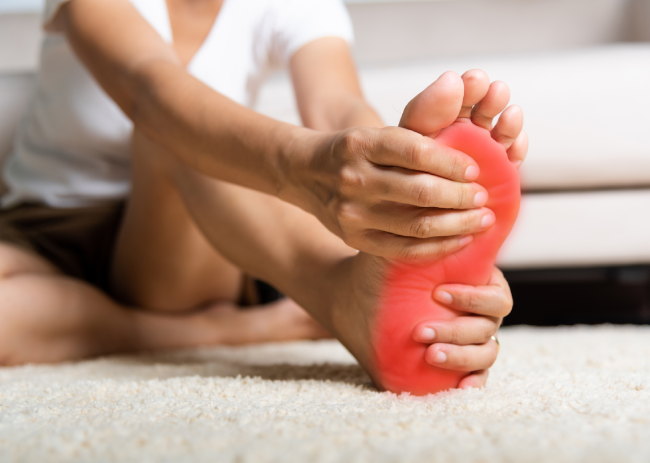Foot Nerve Pain: Is Red Light Therapy the Solution?
Nerve pain can take place due to nerve damage or nerve compression. However, it does not necessarily mean you experience this pain in your muscles. It means the foot nerve has been hit or damaged. Instead, it can be any nerve! However, the pain itself can be quite intense, and without the proper care and treatment, it can get worse. So, knowing the symptoms and the things you must consider when having this pain is necessary.
Today, we will discuss all the necessary insights about the feet and nerve anatomy, common symptoms of the pain, and the things you need to consider when you have this pain. So, without further ado, let’s get started!
Anatomy of the Foot and its Nerves
Human feet are a complex structure that includes muscles, nerves, bones, and ligaments. All work together to help us move and stay balanced.
Now, the foot itself is divided into 3 parts:
- The midfoot
- The hindfoot
- The forefoot
Your forefoot includes the phalanges (the toes) and metatarsal bones. The midfoot comes with an arch supported by the tarsals. And finally, the hindfoot is supported by the calcaneus (heel bone) and ankle bones.
Nerves, on the other hand, are essential for movements and sensations. The main nerve of your feet is the tibial nerve. This runs just along your leg and is responsible for sensations with the help of the plantar nerves.
With this simple and brief anatomy of the feet and nerves, you can understand the surface of how your feet and nerves are connected.
Let’s Check Some Common Symptoms
There can be many different symptom types for peripheral neuropathy. This condition may have a drastic impact on a specific nerve. In this case, it’s nerve pain.
Also, let’s check out the Nerve pain remedies with red light therapy.
That’s not all; the symptoms can even depend on the type of nerve signal being affected!
Here are the symptom types:
- Autonomic
- Sensory and pain
- Motor
Motor Symptoms
1. Muscle Paralysis and Weakness
Nerve degradation due to peripheral neuropathy can significantly affect and weaken your connected muscles.
This can result in paralysis, making it difficult to move your toes or even drop your foot. Not only this, but it can also affect the muscles of your arms and thighs.
2. Muscle Atrophy
Disruption of the nerve connections can lead your muscles to shrink. It also weakens the muscles over time. This mainly happens in your feet, hands, and lower legs. This can be one of the possible reasons for the intense foot nerve pain.
3. Uncontrollable Muscle Movements
Sometimes, the nerves that lose their connection with the brain can become hyperactive, resulting in cramps and foot nerve pain. This loss of nerve-brain connection is one of the possible symptoms of foot nerve pain.
Sensory Symptoms
1. Tingling
This mainly happens when there are problems with your nerves, which are responsible for carrying signals to the brain. This can be one of the reasons you have foot nerve pain.
2. Numbness
Numbness is one of the possible symptoms that cause trouble relaying signals. This loss in certain sensation types is one of the symptoms of foot nerve pain. With time, you’ll feel the pain, and this numbness will just increase.
3. Clumsiness And Imbalancement
Nerves even carry certain sensations that the brain uses to track the location of your feet and hands. You are completely unaware of such sensations critical for coordination and balance.
Without such sensations, you may experience a severe loss of balance and clumsiness. This can even be a possible symptom that you’ll be having foot nerve pain anytime soon.
4. Feet Muscle Weakness
Muscle weakness is one of the symptoms of foot nerve pain. The pain can drastically increase, and this can also lead to walking troubles. And when such symptoms show up, you must first consult with an expert to confirm the issue.
Autonomic Symptoms
1. Changes in Blood Pressure
The body automatically manages the blood pressure, but disruption to the peripheral nerves can damage this. It can even result in certain drops in your blood pressure or even increase your heart rate.
2. Excessive Sweat or Not at All
Your body has a mechanism to automatically manage your internal temperature, using the “sweating process” to regulate heat.
However, when your peripheral nerve gets damaged, it can lead you to excessive sweat.
This process can lead to drastic scaling and dryness on your feet. You can even start to sweat a lot after taking a meal.
3. Bladder and Bowel Issues
Autonomic signals control the bladder and bowel without you needing to make or even think about them to work.
Certain nerve fiber disruptions can drastically affect bowel movements. This situation impacts your bladder control and results in foot nerve pain.
What Are The Variations in Pain?
Morton’s neuroma is one of the examples of foot nerve pain. This condition can cause severe pain that can cause you a lot of pain.
The condition is a pretty common foot nerve problem where you may feel some sort of burning sensation and pain in your front leg, especially between the toes. And the bad news is that this pain can only get worse with time.
Plus, it’s not just the burning pain that’ll cause suffering; numbness and tingling sensations may also join up! Usually, situations go out of hand when you do everyday activities and become challenged due to this condition.
However, many healthcare experts believe red light therapy can be ideal for tackling foot nerve pain issues.
This is because, with consistent and regular use of light therapy, patients will have a drastic fall in inflammation levels, improvement of blood circulation, nerve regeneration, and, most importantly, pain relief.
However, the improvements won’t be seen immediately. To get the best of it, you need to ensure that you’re consistent and use the authentic device.
Yet, we’ll always recommend you consult a healthcare professional first and know the best treatment for your case.
What To Consider While Having Foot Nerve Pain?
In this section, we’ve listed some of the possible considerations you need to consider when you have foot nerve pain.
- Wearing those shoes that are well-cushioned reduces the stress on the feet. This way, you won’t have any direct high-impact on your movements.
- Getting customized orthotic inserts can give you support and relieve your nerve pressure.
- Ice packs can also be a great way to subside the pain, or you can even use topical creams to get temporary relief.
- Maintaining a healthy lifestyle and having control over your weight and stress can play a huge role in relieving you of foot nerve pain
- Wearing tight shoes can elevate nerve pain, so it’s recommended that you wear shoes that have a wider toe space,
Which Possible Symptoms of Foot Nerve Pain Are You Having?
After going through this blog, I believe you should now have a clear understanding of all the symptoms of foot nerve pain.
The pain can be intense, and there can be several possible symptoms with this condition; if not addressed at the right time, the condition can get worse.
According to many experts, red light therapy can be a remarkable treatment option, as it aids with inflammation, nerve regeneration, and blood circulation to reduce tingling or numbness.
However, we’ll always recommend you first consult an expert regarding your problems. This way, you’ll know what your condition is and the possible treatments that are best for you.




